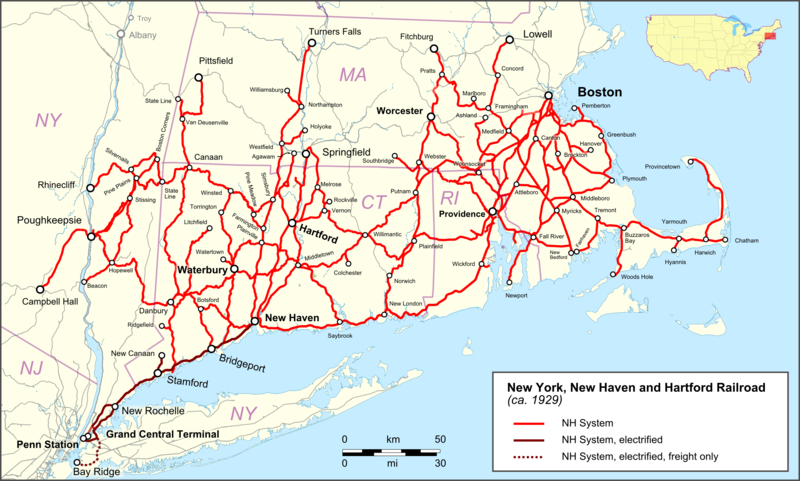Atun-Shei Films
Published 20 Jan 2023Native American living historians Drew Shuptar-Rayvis and Dylan Smith help me explore the military history of King Philip’s War from the indigenous perspective.
(more…)
January 26, 2023
Indigenous Weapons and Tactics of King Philip’s War
September 7, 2021
Fallen Flag — the New York, New Haven & Hartford Railroad

Around the beginning of the 20th century, New York investors led by J. P. Morgan gained control, and in 1903 installed Charles S. Mellen as President. Charles Francis Murphy’s New York Contracting and Trucking company was awarded a $6 million contract in 1904 to build rail lines in the Bronx for the New York, New Haven, and Hartford Railroad. An executive at the railroad said the contract was awarded to avoid friction with New York City’s Tammany Hall political machine. In response to this contract, the New York State Legislature amended the city’s charter so that franchise-awarding power was removed from the city council and given to the Board of Estimate and Apportionment, which only recently became defunct in 1989. Morgan and Mellen achieved a complete monopoly of transportation in southern New England, purchasing other railroads and steamship and trolley lines. More than 100 independent railroads eventually became part of the system before and during these years, reaching 2,131 miles at its 1929 peak. Substantial improvements to the system were made during the Mellen years, including electrification between New York and New Haven. […] Morgan and Mellen went further and attempted to acquire or neutralize competition from other railroads in New England, including the New York Central’s Boston and Albany Railroad, the Rutland Railroad, the Maine Central Railroad, and the Boston and Maine Railroad. But the Morgan-Mellen expansion left the company overextended and financially weak.
In 1914, 21 directors and ex-directors of the railroad were indicted for “conspiracy to monopolize interstate commerce by acquiring the control of practically all the transportation facilities of New England.”
J.W. Swanberg carries on the story of the railroad’s woes during and after the First World War:
The New Haven was a financial powerhouse at the start of the 20th century, but from 1903 to 1913, the road was driven to near bankruptcy under President Charles S. Mellen and financier J.P. Morgan. One gain in this period, though, was control of the Central New England Railway, which included the Hudson River bridge at Poughkeepsie, N.Y., and the link to Maybrook and nearby Campbell Hall. This was New Haven’s gateway to the west, also served by trunk lines Erie; New York, Ontario & Western; and bridge lines Lehigh & Hudson River and Lehigh & New England.
World War I government control and the Roaring 1920s boom times saved the New Haven, but not enough to survive the Great Depression, and bankruptcy came in 1935. World War II traffic allowed recovery and rebuilding, but soon all was lost by mismanagement and bankruptcy came again in 1961. The postwar New Haven faced not only highway and airline competition but also the almost total erosion of New England’s heavy industrial base. Just a shell of the once-mighty railroad was forced into a reluctant Penn Central on Jan. 1, 1969.
One of the line’s claim to fame was the early electrification program the New Haven embarked on in 1907:

“View of Typical Sectionalizing Bridge, Auto-Transformer Installation and Cable Runway May 2, 1914.”
Photo and original caption from Electric Railway Journal via Wikimedia Commons.
The New York, New Haven and Hartford Railroad pioneered electrification of main line railroads using high-voltage, alternating current, single-phase overhead catenary. It electrified its mainline between Stamford, Connecticut, and Woodlawn, New York, in 1907, and extended the electrification to New Haven, Connecticut, in 1914. While single-phase AC railroad electrification has become commonplace, the New Haven’s system was unprecedented at the time of construction. The significance of this electrification was recognized in 1982 by its designation as a National Historic Engineering Landmark by the American Society of Mechanical Engineers (ASME).
[…]
The New Haven’s system was extended across the Hell Gate Bridge to the New York Connecting Railroad upon the line’s construction. The system of electrification was an extension of the New Haven’s revised 11/22 kV autotransformer architecture. The original electrification extended from the New Haven’s main line, across the Hell Gate Bridge, to the Bay Ridge yard. The line south of Bowery Bay Junction was de-electrified in the 1950s. The line between New Rochelle and the Harold Interlocking was transferred to Amtrak in 1976 upon dissolution of Penn Central. The electrification system continued to be controlled as a portion of the ex-New Haven system until the 1987 conversion to 60 Hz operation.
When the New Haven main line was converted by Metro-North to 60 Hz operation, the Amtrak Hell Gate line was also converted, but as an isolated system powered from the Van Nest substation. Control of the catenary system was transferred from Cos Cob to the Load Dispatcher at New York Penn Station. Although conversion occurred subsequent to the PRR-era electrification, Amtrak substation numbers 45-47 were assigned for consistency with the rest of the PRR numbering scheme.
October 7, 2020
The Great Swamp Fight: The Bloodiest Day of King Philip’s War
Atun-Shei Films
Published 6 Oct 2020In December 1675, in the midst of King Philip’s War, an army of Puritan colonists made a preemptive strike against the neutral Narragansett tribe. Their desperate battle in the snowy wilderness of Rhode Island became a touchstone in the cultural lore of Anglo New England, while the subsequent massacre would go down as the darkest, most tragic event in Narragansett history.
Support Atun-Shei Films on Patreon ► https://www.patreon.com/atunsheifilms
Leave a Tip via Paypal ► https://www.paypal.me/atunsheifilms (All donations made here will go toward the production of The Sudbury Devil, our historical feature film)
Buy Merch ► teespring.com/stores/atun-shei-films
#KingPhilipsWar #NewEngland #AmericanHistory
Original Music by Dillon DeRosa ► http://dillonderosa.com/
Reddit ► https://www.reddit.com/r/atunsheifilms
Twitter ► https://twitter.com/atun_shei~REFERENCES~
[1] Eric Schultz and Michael Tougias. King Philip’s War: The History and Legacy of America’s Forgotten Conflict (1999). The Countryman Press, Page 269
[2] Douglas Leach. Flintlock and Tomahawk: New England in King Philip’s War (1958). Parnassus Imprints, Page 58-62
[3] Leach, Page 112-117
[4] Schultz & Tougias, Page 246-247
[5] Schultz & Tougias, Page 247-255
[6] Leach, Page 127-129
[7] Schultz & Tougias, Page 259
[8] Leach, Page 129
[9] Leach, Page 148-149
[10] Joseph Dudley. Second Letter of Joseph Dudley (2001). Bigelow Society http://bigelowsociety.com/rod/battles…
[11] Schultz & Tougias, Page 260-261
[12] Leach, Page 130-131
[13] Benjamin Church. Entertaining Passages Relating to King Philip’s War, Tercentenary Edition (1975). Pequot Press, Page 95-102
[14] Schultz & Tougias, Page 264-265
[15] Leach, Page 131
[16] Church, Page 101
[17] “History – Perseverance.” Narragansett Indian Nation http://narragansettindiannation.org/h…
September 1, 2020
King Philip’s War: The Most Important American War You’ve Never Heard Of
[Update, 29 Dec 2022 – Andy has uploaded a new video to correct some of the errors he made in this presentation.]
Atun-Shei Films
Published 9 Jan 2019A generation after the first Thanksgiving, the sachem of the Wampanoag led a coalition of Native American tribes to battle against the ever-encroaching European colonists of New England.
(more…)
March 16, 2017
Words & Numbers: Blocked by a State’s Wall of Taxes
Published on 15 Mar 2017
This week, James & Antony discuss the case of Connecticut’s budget shortfall. The state hopes to solve their financial problems by raiding the retirement accounts of previous Connecticut government employees who have moved out of the state, and take 30% of those savings. This plan would hurt retirees, break promises, and trap many people in the state based on a policy that may be illegal.
April 23, 2014
Happy Meal toys as human rights violations
Amy Otto on the attempt to sue McDonald’s because they were handing out “gendered” toys with their Happy Meals:
A recent article in Slate by Antonia Ayres-Brown, a junior in high school, details the valiant feminist struggle she ultimately brought to the Connecticut Commission on Human Rights and Opportunities against McDonald’s for … discriminating on the basis of sex in the distribution of Happy Meal toys. “Despite our evidence showing that, in our test, McDonald’s employees described the toys in gendered terms more than 79 percent of the time, the commission dismissed our allegations as ‘absurd’ and solely for the purposes of ‘titilation [sic] and sociological experimentation,’” she wrote.
Let’s leave aside the fact that Connecticut has a Commission on Human Rights and note that this girl sincerely believes McDonald’s offering toys described, at times, as being for a girl or for a boy is a human rights violation.
While I admire the girl’s plucky disposition and effort, I do hope one day she learns to channel her energy into productive uses that will advance her cause in positive ways. This could have all been solved by her parents simply encouraging her to ask for the toy she wants. If girls are continually taught that they as individuals have no power to negotiate a situation as simple as “I’d like that toy” without the Connecticut Commission on Human Rights getting involved, I submit that these women are proving the case that they should not be put in positions of leadership or power.
By the author’s own admission,“McDonald’s is estimated to sell more than 1 billion Happy Meals each year.” Yet it does not occur to her that the fast food worker giving a “girl’s” toy to a girl is simply trying to give the customer what she wants in the most expeditious manner possible. This is a company that sells a billion of these things a year and gets them in the hands of their customers as fast as possible.
People do not eat at McDonald’s to get into a gender studies discussion with the teenage kid at the register; they go there to get food fast, hence the term “fast food.” If the author had worked in fast food for any nominal period of time, she might realize that the employee’s main motivation is not to spend any time persecuting women but to make it through his or her shift as painlessly as possible.
February 15, 2014
In one stroke, Connecticut becomes the state with the highest proportion of criminals
In a development that absolutely nobody could have seen coming, Connecticut has the highest known population of (technical) criminals in the United States:
In a massive display of civil disobedience, tens of thousands of state residents have refused to register what the left calls assault weapons, instantly making them criminals guilty of a felony.
The legacy of the Connecticut residents who used their privately owned firearms to help overthrow the tyrannical colonial rule of King George III, who probably considered their muskets the military-style assault weapon of the day, apparently lives on.
Connecticuters in the tens, perhaps hundreds, of thousands have refused to comply with a law, adopted after the December 2012 massacre at Sandy Hook Elementary School, requiring them to register what gun-control advocates consider assault weapons by the end of 2013.
As the Hartford Courant reports, as of Dec. 31 some 47,916 applications for assault weapons certificates had been received by state police. By some estimates, this represented as little as 15% of the rifles classified as assault weapons owned by Connecticut residents.
Estimates by people in the industry, including the Newtown-based National Shooting Sports Foundation, place the number as high as 350,000.
Update, 19 February: The editorial board of the Hartford Courant thinks that the solution to this problem is to just ignore the deadline or even scrap the law. No, wait, that’d be a sensible reaction. They actually want the state to round up the scofflaws en masse:
Some people actually tried to comply with the registration law, but missed the deadline. The state’s official position is that it will accept applications notarized on or before January 1, 2014 and postmarked by January 4. But, says Dora Schriro, Commissioner of the Department of Emergency Services and Public Protection, in a letter to lawmakers [PDF], anybody sufficiently law-abiding but foolish enough to miss that slightly extended grace period will have to surrender or otherwise get rid of their guns.
This, of course, is the eternally fulfilled fear of those who oppose registration of things governments don’t like — that allowing the government to know about them will result in their eventual confiscation. Such confiscation, despite assurances to the contrary, occurred in New York, California, and elsewhere. Connecticut has accomplished something special, though, by making “eventual” a synonym for “right now.”
You know who won’t have to surrender their weapons? People who quietly told the state to fuck off.
This successful example of mass defiance horrifies the editorial board of the Hartford Courant, which shudders at the sight of the masses not obeying an order that, history, tells us, never had a shot at wide compliance. According to them:
It’s estimated that perhaps scores of thousands of Connecticut residents failed to register their military-style assault weapons with state police by Dec. 31….
…the bottom line is that the state must try to enforce the law. Authorities should use the background check database as a way to find assault weapon purchasers who might not have registered those guns in compliance with the new law.
A Class D felony calls for a maximum sentence of five years in prison and a $5,000 fine. Even much lesser penalties or probation would mar a heretofore clean record and could adversely affect, say, the ability to have a pistol permit.
If you want to disobey the law, you should be prepared to face the consequences.
Such shock! Such outrage!
January 16, 2013
When Kafka met Sandy
In the Wall Street Journal, Roger Kimball talks about the experience of trying to put your life back together after a major storm damages your home:
Like many people whose houses were badly damaged by Hurricane Sandy, my family and I have been living in a rented house since the storm. Unlike some whose houses were totalled, we could have repaired things and been home toasting our tootsies by our own fireplace by now. What happened?
Two things: zoning (as in “Twilight Zone”) and FEMA.
Our first exposure to the town zoning authorities came a couple of weeks after Sandy. We’d met with insurance adjusters, contractors and “remediation experts.” We’d had about a foot of Long Island Sound sloshing around the ground floor of our house in Connecticut, and everyone had the same advice: Rip up the floors and subfloors, and tear out anything — wiring, plumbing, insulation, drywall, kitchen cabinets, bookcases — touched by salt water. All of it had to go, and pronto, too, lest mold set in.
Yet it wasn’t until the workmen we hired had ripped apart most of the first floor that the phrase “building permit” first wafted past us. Turns out we needed one. “What, to repair our own house we need a building permit?”
Of course.
Before you could get a building permit, however, you had to be approved by the Zoning Authority. And Zoning — citing FEMA regulations — would force you to bring the house “up to code,” which in many cases meant elevating the house by several feet. Now, elevating your house is very expensive and time consuming — not because of the actual raising, which takes just a day or two, but because of the required permits.
Kafka would have liked the zoning folks. There also is a limit on how high in the sky your house can be. That calculation seems to be a state secret, but it can easily happen that raising your house violates the height requirement. Which means that you can’t raise the house that you must raise if you want to repair it. Got that?
“A paradox, a paradox, a most ingenious paradox. Ha, ha, ha, ha, ha, ha, ha, ha, this paradox.”
H/T to Monty for the link. Monty also has this meditation on bureaucracy:
This is where Leviathan does the most damage, I think. Tyranny is always a danger in centralized governments, but a greater danger is the proliferation and growth of bureaucracies. The rules become ever more Byzantine, ever more contradictory, ever more pointless, and ever more expensive (both to implement and comply with). The bureaucracies themselves achieve a life outside the body politic: they persist, age after age, irrespective of their political origin. Their sole imperative (regardless of their ostensible purpose) is to perpetuate themselves. They are an amoeba, growing to engulf everything they touch — not because they are evil, necessarily, but simply because it’s in their nature to do so. They cannot help themselves. Bureaucracies — lethargic, slow, risk-averse, rules-bound, pedantic, expensive, often causing more harm than good — are perhaps the very worst creation of human society.






